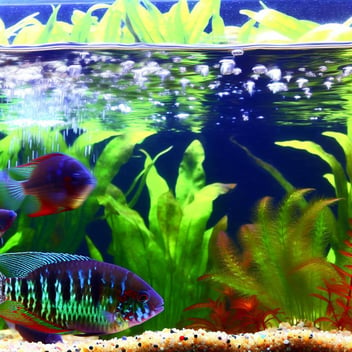Discover the best practices for caring for weeping moss in your aquarium or terrarium.
Understanding Weeping Moss
Weeping moss (Taxiphyllum sp.) is a popular choice for aquarists and terrarium enthusiasts due to its unique appearance and low maintenance requirements. This species of moss features drooping fronds that resemble the branches of a weeping willow tree, hence its name. Understanding the characteristics and growth patterns of weeping moss is essential for providing the optimal care it needs.
One important aspect to note about weeping moss is its preference for low to medium lighting conditions. It thrives best in shaded areas where direct sunlight is limited. When exposed to intense light, weeping moss may turn brown and lose its vibrant green color. Therefore, it's crucial to place your aquarium or terrarium in a location that provides diffused or indirect lighting.
Additionally, weeping moss is a slow-growing species, which means it requires minimal pruning compared to other types of aquarium plants. However, regular maintenance is still necessary to prevent the moss from overgrowing and shading other plants in your tank. By understanding the growth habits and lighting preferences of weeping moss, you can create an ideal environment for its long-term health and beauty.
Choosing the Right Environment
Creating the perfect environment for weeping moss involves considering various factors such as temperature, water quality, and substrate. This species of moss thrives in temperatures ranging from 70 to 78 degrees Fahrenheit (21 to 26 degrees Celsius). It's important to maintain a stable temperature within this range to ensure optimal growth and prevent temperature fluctuations from stressing the moss.
In terms of water quality, weeping moss prefers slightly acidic to neutral water conditions. The pH level should ideally be between 6.0 and 7.5. It's recommended to use a high-quality water test kit to regularly monitor and adjust the pH level as needed. Additionally, maintaining proper water circulation and filtration is essential for preventing the accumulation of debris and ensuring adequate oxygen levels for the moss.
When it comes to substrate, weeping moss can attach itself to various surfaces such as rocks, driftwood, or even aquarium walls. However, providing a substrate that promotes attachment and growth can enhance the overall appearance of the moss. Fine-grained sand or gravel is often a suitable choice as it allows the moss to anchor itself securely.
By carefully selecting the right environment for your weeping moss, you can create a thriving habitat that showcases the beauty of this unique plant.
Proper Watering Techniques
Maintaining proper hydration is crucial for the health and vitality of weeping moss. While it doesn't require frequent watering like traditional plants, ensuring adequate moisture levels is still important.
One effective watering technique for weeping moss is misting. Using a spray bottle filled with dechlorinated water, gently mist the moss to provide moisture without saturating it. This mimics the natural rainfall that the moss would receive in its native habitat.
Another method is to soak the moss in a container of dechlorinated water for a few minutes. This allows the moss to absorb the necessary moisture without becoming waterlogged. After soaking, gently squeeze out any excess water before placing the moss back in its designated location.
It's important to strike a balance between providing enough moisture for the moss to thrive and avoiding overwatering, which can lead to the growth of algae or the development of root rot. Regularly monitoring the moisture levels and adjusting your watering routine accordingly is key to maintaining the health of your weeping moss.
Fertilizing and Pruning
While weeping moss generally doesn't require frequent fertilization, providing it with essential nutrients can promote healthy growth and vibrant coloration. One option is to use liquid fertilizers specifically formulated for aquarium plants. These fertilizers usually contain a balanced blend of macro and micronutrients that are readily absorbed by the moss.
When applying fertilizer, it's important to follow the manufacturer's instructions and avoid excessive use, as this can lead to algae growth or nutrient imbalances. It's recommended to fertilize weeping moss once every two to four weeks, depending on the specific needs of your tank.
In terms of pruning, weeping moss requires minimal maintenance due to its slow growth rate. However, occasional trimming may be necessary to prevent the moss from overshadowing other plants or obstructing the view in your aquarium or terrarium. Use clean, sharp scissors or aquatic plant trimming tools to carefully trim away any excess growth. By keeping the moss well-maintained, you can ensure its overall health and aesthetic appeal.
Dealing with Common Issues
Like any other aquarium or terrarium plant, weeping moss may encounter certain issues that require attention and troubleshooting.
One common issue is the accumulation of algae on the moss. Algae growth can hinder the growth and appearance of weeping moss. To prevent algae overgrowth, ensure proper water circulation, maintain a balanced lighting schedule, and avoid overfeeding your aquarium or terrarium inhabitants. Additionally, manually removing any visible algae from the moss can help keep it clean and healthy.
Another issue to watch out for is the presence of pests or diseases. While weeping moss is generally resistant to common pests and diseases, it's still important to regularly inspect the moss for any signs of infestation or abnormalities. If you notice any pests or suspect a disease, take appropriate measures such as quarantining affected plants, using natural pest control methods, or seeking advice from a knowledgeable aquarium or terrarium expert.
By promptly addressing any issues that arise and taking proactive measures to maintain a healthy environment, you can ensure the long-term success of your weeping moss.
Additional Resources:
Live Aquarium Plants - The Ultimate Guide
The Beauty Of Java Moss
Discover The Beauty Of Willow Moss




Leave a Comment